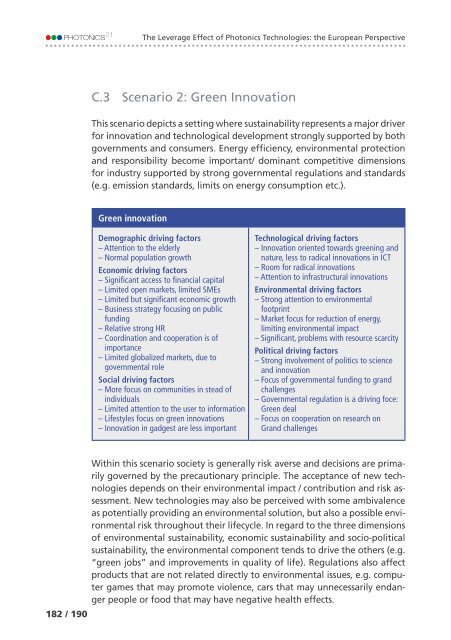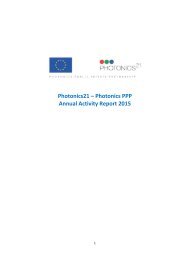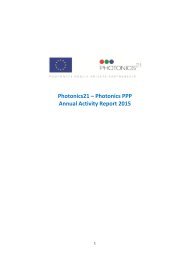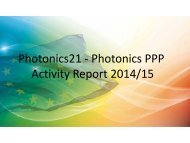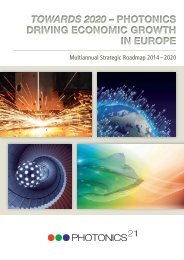of Photonics Technologies: the European Perspective The Leverage Effect
Create successful ePaper yourself
Turn your PDF publications into a flip-book with our unique Google optimized e-Paper software.
<strong>The</strong> <strong>Leverage</strong> <strong>Effect</strong> <strong>of</strong> <strong>Photonics</strong> <strong>Technologies</strong>: <strong>the</strong> <strong>European</strong> <strong>Perspective</strong><br />
C.3 Scenario 2: Green Innovation<br />
This scenario depicts a setting where sustainability represents a major driver<br />
for innovation and technological development strongly supported by both<br />
governments and consumers. Energy efficiency, environmental protection<br />
and responsibility become important/ dominant competitive dimensions<br />
for industry supported by strong governmental regulations and standards<br />
(e.g. emission standards, limits on energy consumption etc.).<br />
Green innovation<br />
Demographic driving factors<br />
– Attention to <strong>the</strong> elderly<br />
– Normal population growth<br />
Economic driving factors<br />
– Significant access to financial capital<br />
– Limited open markets, limited SMEs<br />
– Limited but significant economic growth<br />
– Business strategy focusing on public<br />
funding<br />
– Relative strong HR<br />
– Coordination and cooperation is <strong>of</strong><br />
importance<br />
– Limited globalized markets, due to<br />
governmental role<br />
Social driving factors<br />
– More focus on communities in stead <strong>of</strong><br />
individuals<br />
– Limited attention to <strong>the</strong> user to information<br />
– Lifestyles focus on green innovations<br />
– Innovation in gadgest are less important<br />
Technological driving factors<br />
– Innovation oriented towards greening and<br />
nature, less to radical innovations in ICT<br />
– Room for radical innovations<br />
– Attention to infrastructural innovations<br />
Environmental driving factors<br />
– Strong attention to environmental<br />
footprint<br />
– Market focus for reduction <strong>of</strong> energy,<br />
limiting environmental impact<br />
– Significant, problems with resource scarcity<br />
Political driving factors<br />
– Strong involvement <strong>of</strong> politics to science<br />
and innovation<br />
– Focus <strong>of</strong> governmental funding to grand<br />
challenges<br />
– Governmental regulation is a driving foce:<br />
Green deal<br />
– Focus on cooperation on research on<br />
Grand challenges<br />
182 / 190<br />
Within this scenario society is generally risk averse and decisions are primarily<br />
governed by <strong>the</strong> precautionary principle. <strong>The</strong> acceptance <strong>of</strong> new technologies<br />
depends on <strong>the</strong>ir environmental impact / contribution and risk assessment.<br />
New technologies may also be perceived with some ambivalence<br />
as potentially providing an environmental solution, but also a possible environmental<br />
risk throughout <strong>the</strong>ir lifecycle. In regard to <strong>the</strong> three dimensions<br />
<strong>of</strong> environmental sustainability, economic sustainability and socio-political<br />
sustainability, <strong>the</strong> environmental component tends to drive <strong>the</strong> o<strong>the</strong>rs (e.g.<br />
“green jobs” and improvements in quality <strong>of</strong> life). Regulations also affect<br />
products that are not related directly to environmental issues, e.g. computer<br />
games that may promote violence, cars that may unnecessarily endanger<br />
people or food that may have negative health effects.


